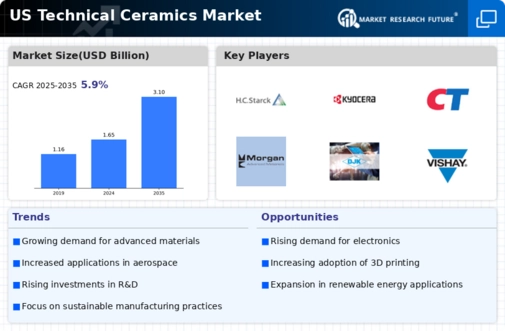The US Technical Ceramics Market is characterized by its dynamic landscape, with a variety of companies operating in this essential sector, each contributing unique expertise and innovations. This market comprises a diverse array of applications including electronics, aerospace, defense, medical, and energy, which collectively drive demand for high-performance ceramic materials.
Competitive insights reveal that companies must continually adapt to emerging technologies, regulatory changes, and customer requirements to maintain their market positions. The presence of established players, along with ongoing research and development efforts, contribute significantly to the evolving dynamics of this market, underscoring the importance of strategic partnerships, sustainability initiatives, and tailored solutions to meet the specific needs of various industries.
H.C. Starck has established itself as a key player in the US Technical Ceramics Market, leveraging its expertise in the production of advanced ceramic materials with exceptional durability and thermal resistance. The company excels in providing high-quality products that cater to industries such as electronics and aerospace, where performance reliability is crucial.
With a strong reputation for innovation, H.C. Starck focuses on research and development to enhance its offerings, ensuring that it stays ahead of the competition. Additionally, the company benefits from a well-developed supply chain and distribution network within the US, enabling it to respond effectively to market demands and customer needs, thereby solidifying its position in this competitive landscape.
Kyocera is another pivotal participant in the US Technical Ceramics Market, known for its diverse range of products including cutting tools, industrial ceramics, and electronic components. With a robust market presence, Kyocera is recognized for its commitment to quality and technological advancement, which allows it to cater to a wide array of industries such as telecommunications, automotive, and medical devices.
The company’s strengths lie in its extensive research and development capabilities, enabling it to continuously innovate and launch new products that meet specific market needs. In recent years, Kyocera has engaged in strategic mergers and acquisitions to enhance its product portfolio, expand its reach, and drive growth within the US market.
The combination of a strong brand reputation, technological expertise, and a focus on customer satisfaction positions Kyocera as a formidable competitor in the technical ceramics segment.





















Leave a Comment